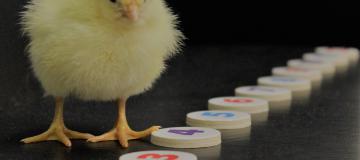
Numerical magnitude, rather than individual bias, explains spatial numerical association in newborn chicks
We associate small numbers with the left and large numbers with the right side of space. Recent evidence from human newborns and non-human animals has challenged the primary role assigned to culture, in determining this spatial numerical association (SNA). Nevertheless, the effect of individual spatial biases has not been considered in previous research. Here, we tested the effect of numerical magnitude in SNA and we controlled for itablendividual biases. We trained 3-day-old chicks (Gallus gallus) on a given numerical magnitude (5). Then chicks could choose between two identical, left or right, stimuli both representing either 2, 8, or 5 elements. We computed the percentage of Left-sided Choice (LC). Numerical magnitude, but not individual lateral bias, explained LC: LC2 vs. 2>LC5 vs. 5>LC8 vs. 8. These findings suggest that SNA originates from pre-linguistic precursors, and pave the way to the investigation of the neural correlates of the number space association.
R. RUGANI, G. VALLORTIGARA, K. PRIFTIS, L. REGOLIN






